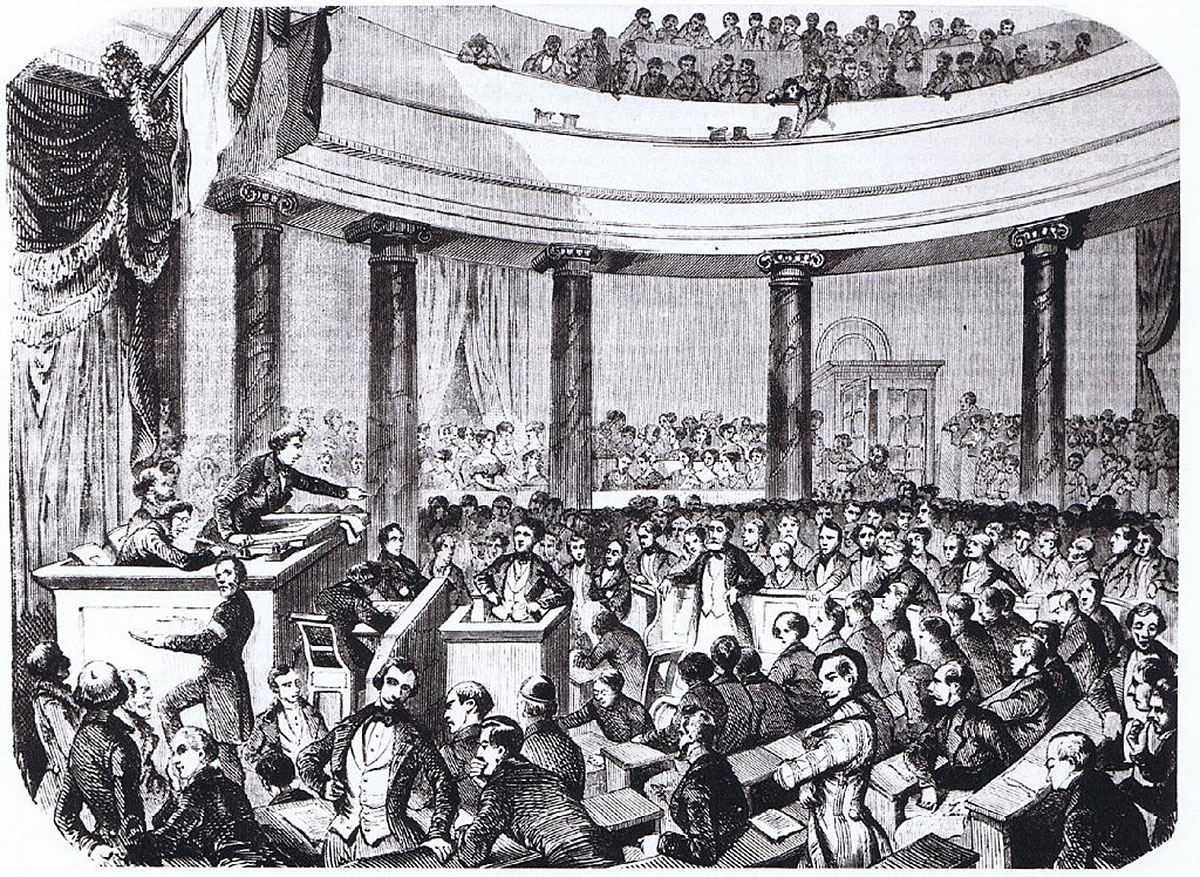 MENU
MENU
 MENU
MENU

Debate in the Assembly of Frankfurt 16 September 1848. This is the same room where the Peace Congress met. As in this picture, ladies at the Peace Congress were relegated to seats in the back. Image courtesy of Mount Holyoke College.
When they arrived in Calais, France, the Hitchcocks were for the first time in deeply Catholic territory, so different from home and from Britain. The cathedrals and abbeys were not ruins or tourist attractions, but in daily use. “We have been rather given to visiting cathedrals & nunneries & viewing relics for the last 2 or 3 days,” Orra remarked in Belgium. “Cathedrals here are not gloomy & damp & uninhabited like those in Eng. but filled with devoted images, candles burning & the perfume of the incense & the people worshipping, priests praying, choirs chanting, organ playing, people confessing, gives a reality to the whole affair.”
Relics fascinated her: “skull of Charlemagne in a silver case,” a cord from the rod used to “smite” Jesus Christ, “skulls of 11,000 virgins, followers of St. Ursula, slaughtered rather than break their vows.” The Hitchcocks' New England Calvinism was aroused: they were alternately awed by the sumptuousness and appalled that “poor deluded people” thought their souls would be saved by relics, ornament, ceremony, and priests. “All seemed too unlike our own simple solemn service that I must confess I got very little good by it,” mused Orra.
They toured Ghent, Aix la Chapelle, Cologne, and Bonn. Edward visited the agricultural school at Poppelsdorf, his first on the continent, and admired the town's natural history collections (especially, for Orra, the shells), museum of antiquities, and library.
The next leg of the trip was to attend a peace congress in Frankfurt as well as to explore the geology and visit agricultural schools. The Hitchcocks joined a large party of other proponents of peace on a steamboat ride down the Rhine from Bonn toward Frankfurt, a distance of about 125 miles, or 200 kilometers. They noticed the terracing and extinct volcanoes along the way, and castles and villages tucked into the base of mountains that rose up to a thousand feet. “The mind, indeed, finds itself drawn at one moment to some historical monument, and the next to scenery of surpassing beauty or sublimity," Edward enthused, "now the bold, overhanging rock, now the deep recess, now the towering mountain, now the quiet dell with its romantic villages; while every where on the north bank, the vine-clad terraces show us what wonders human industry can accomplish.”
In the wake of revolutions and battles to unify the German states into a single entity, Frankfurt was full of armed soldiers ("As yet we have seen more that looks like war than like peace," noted Edward in a letter to a New York newspaper), and some of the conference planners worried that they would be accused of holding a political meeting and stirring up trouble. Thus, the congress was smaller than previous meetings, although the church, which could hold 3,000, was well enough filled to make the event feel successful. Women were welcome to sit in the seats farthest from the speakers. There were over 400 delegates from England and 36 Americans (including Hitchcock, who took an official role at the last minute and gave a speech), but fewer than 50 from Germany and only a smattering from other European countries. In the end, despite tensions inside the meeting and out, the peace congress was conducted peacefully.
Listen to what Orra wrote in her travel diary.